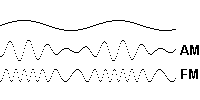Amplitude modulation facts for kids
Amplitude Modulation, often called AM, is a simple way to send radio signals. These signals can travel very far, even across the world! This happens because of a special part of Earth's atmosphere called the ionosphere. The ionosphere acts like a giant mirror, bouncing radio waves back down to Earth.
Imagine a wave, like waves in the ocean. The amplitude of a wave is its height. To send a radio signal, a steady "carrier wave" is used. This carrier wave is then changed, or modulated, by adding the sound you want to send, like music or voices. This combined signal is then sent out over a specific frequency.
One cool thing about AM signals is that they can be picked up by a simple crystal radio. These radios don't need batteries or any other power source! Many early radios were made at home and used earphones to listen.
AM signals are usually sent on medium wave and shortwave frequencies. While the sound quality, or "fidelity," isn't as perfect as some other types of radio, it's good enough to hear clearly. Sometimes, AM signals can get weaker or have interference from things like power lines or power stations. Even sunspot activity on the sun can affect how well the signals travel!
The History of AM Radio
In the 1920s, when commercial broadcasting first started, medium wave AM radio was the main way people listened. This was before television even existed! Radio programs back then were a lot like TV shows today. They included news, sports, drama, music, comedy, and other entertainment.
Later, Frequency Modulation (FM) radio was invented. FM had better sound quality, but its signals couldn't travel as far as AM. So, AM radio stayed important for a long time. After television became popular in the 1950s, AM radio became a major way to listen to popular music. As FM radio became more common in the 1970s, AM stations started to focus more on news and talk shows.
Shortwave Radio
Shortwave radio signals can travel all the way around the world! Because of this, many countries use shortwave radio to send programs to people in distant places. These programs often share news about the country, show examples of their culture and history, and sometimes even offer foreign language lessons.
Images for kids
-
One of the first vacuum tube AM radio transmitters, built in 1913. It was much smaller than earlier transmitters.
See also
 In Spanish: Amplitud modulada para niños
In Spanish: Amplitud modulada para niños







